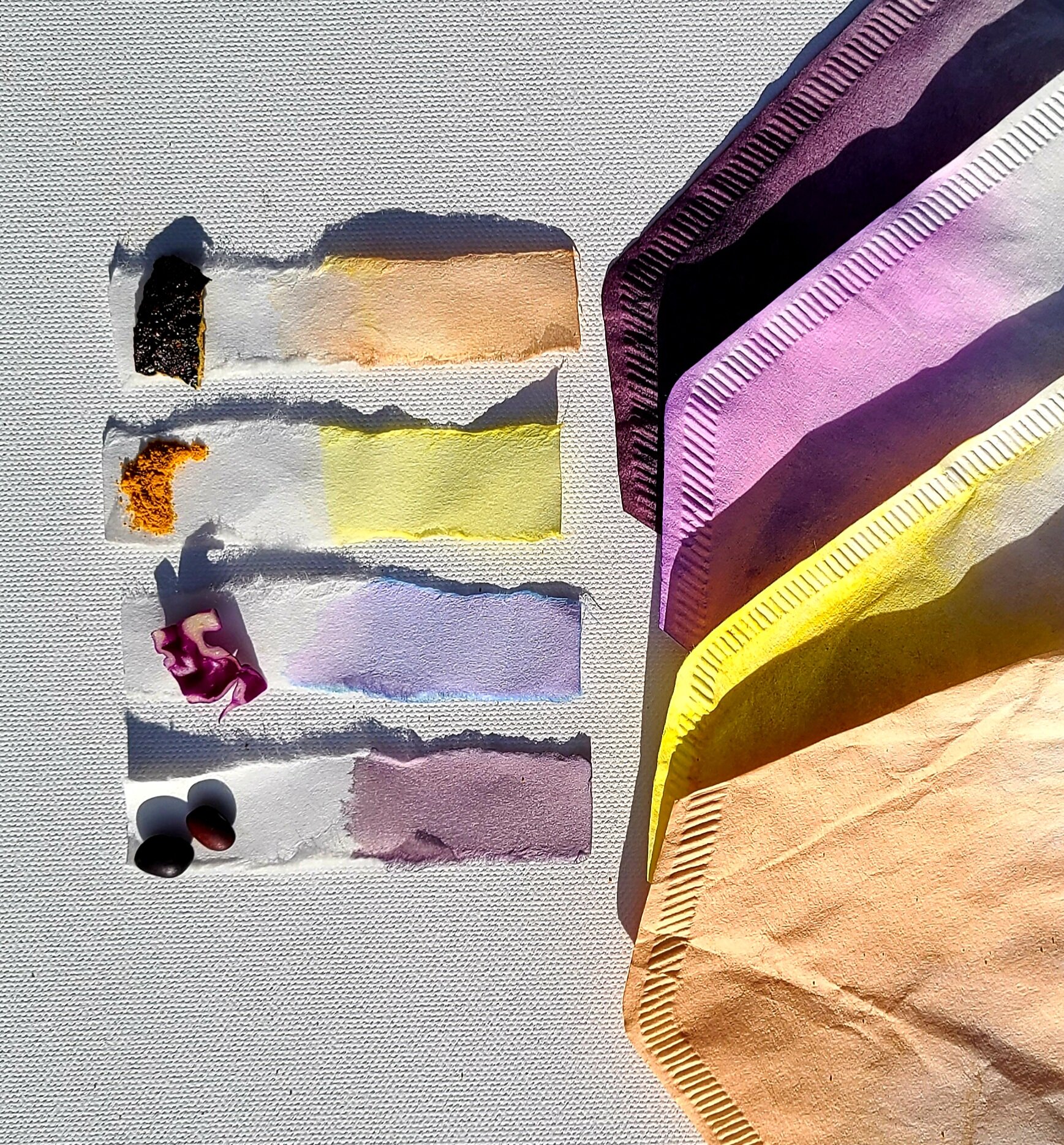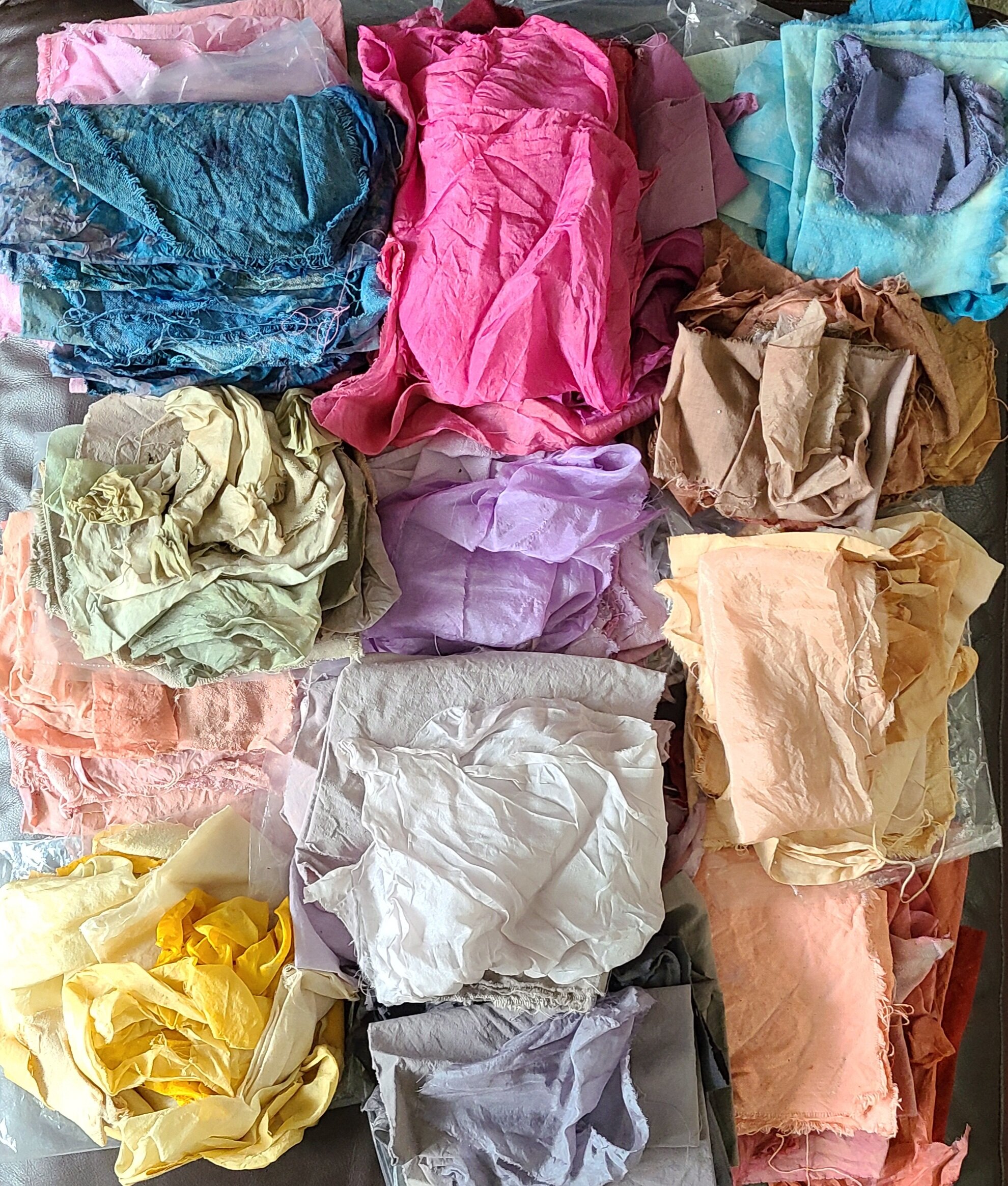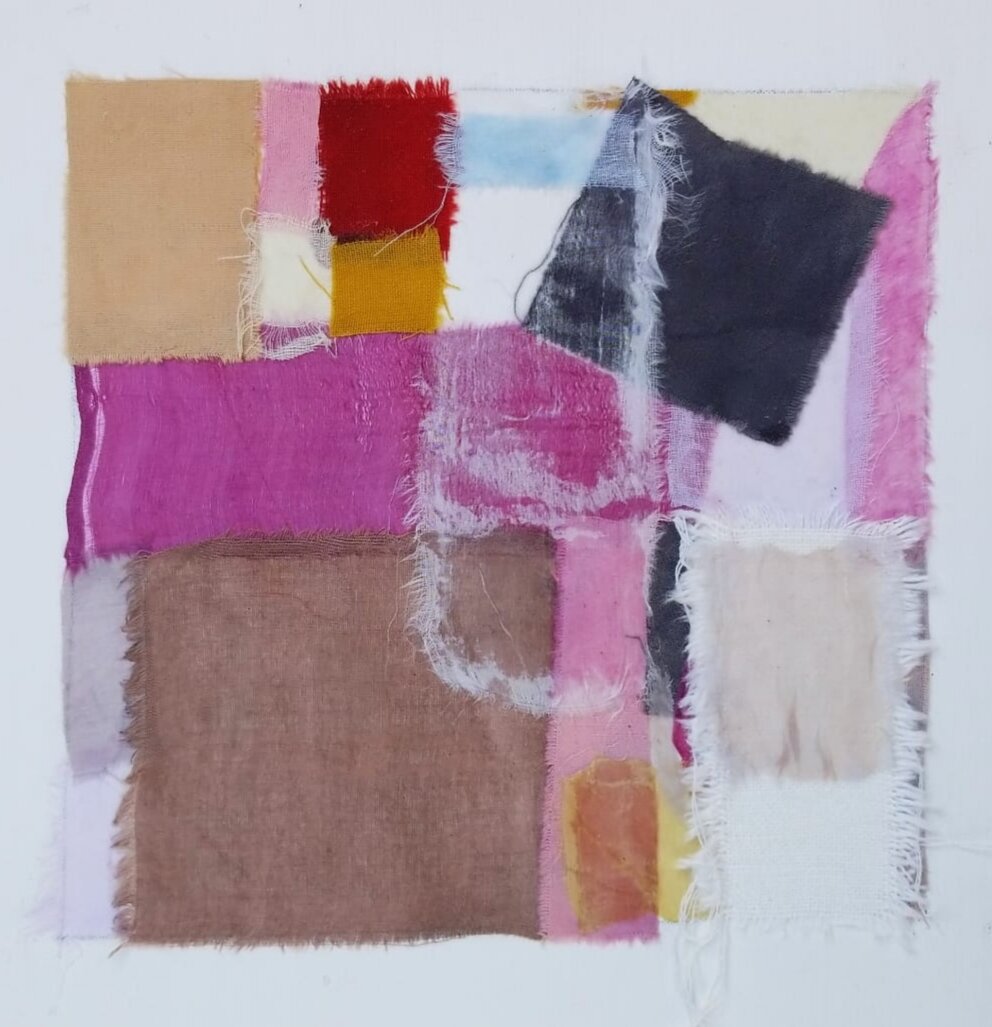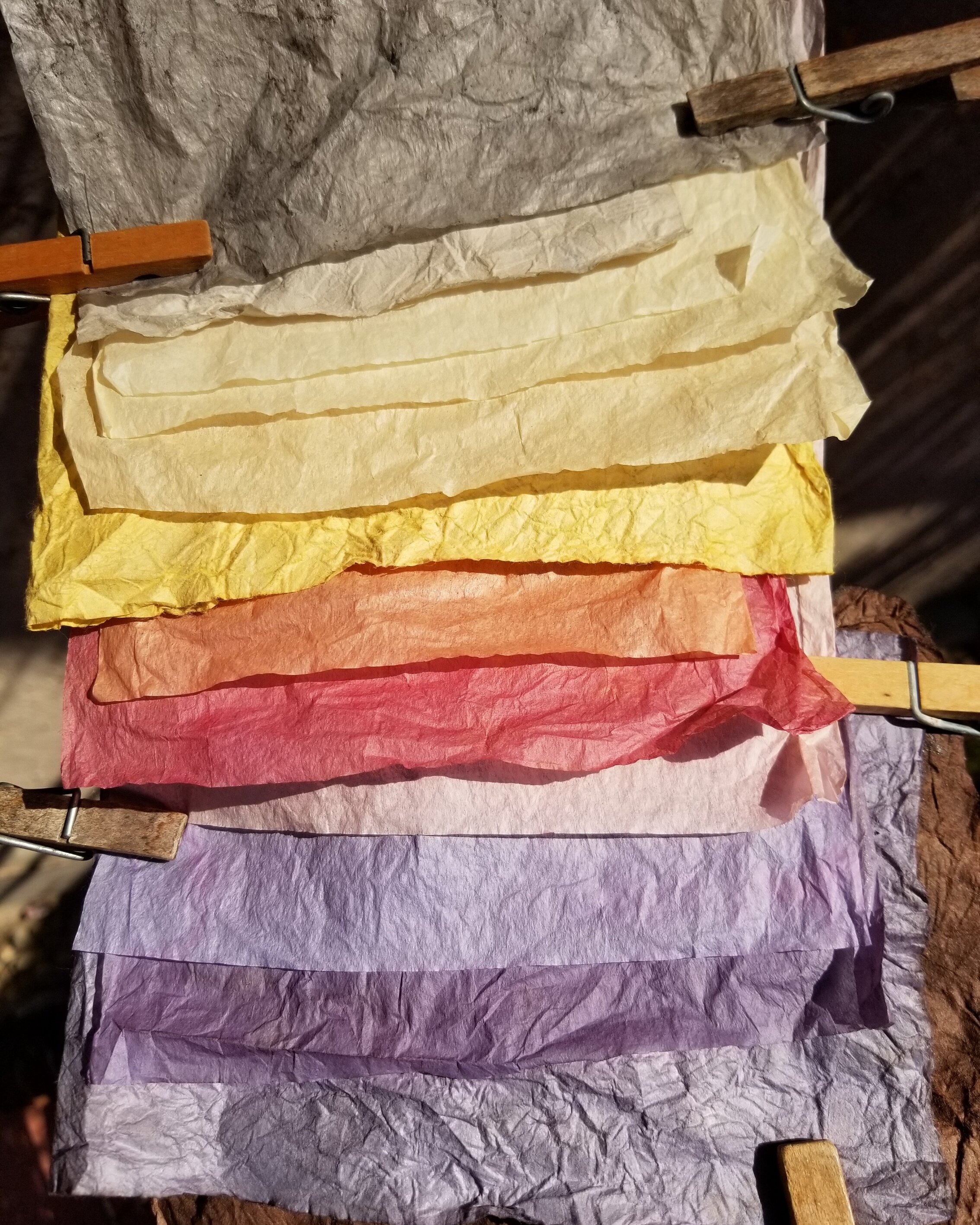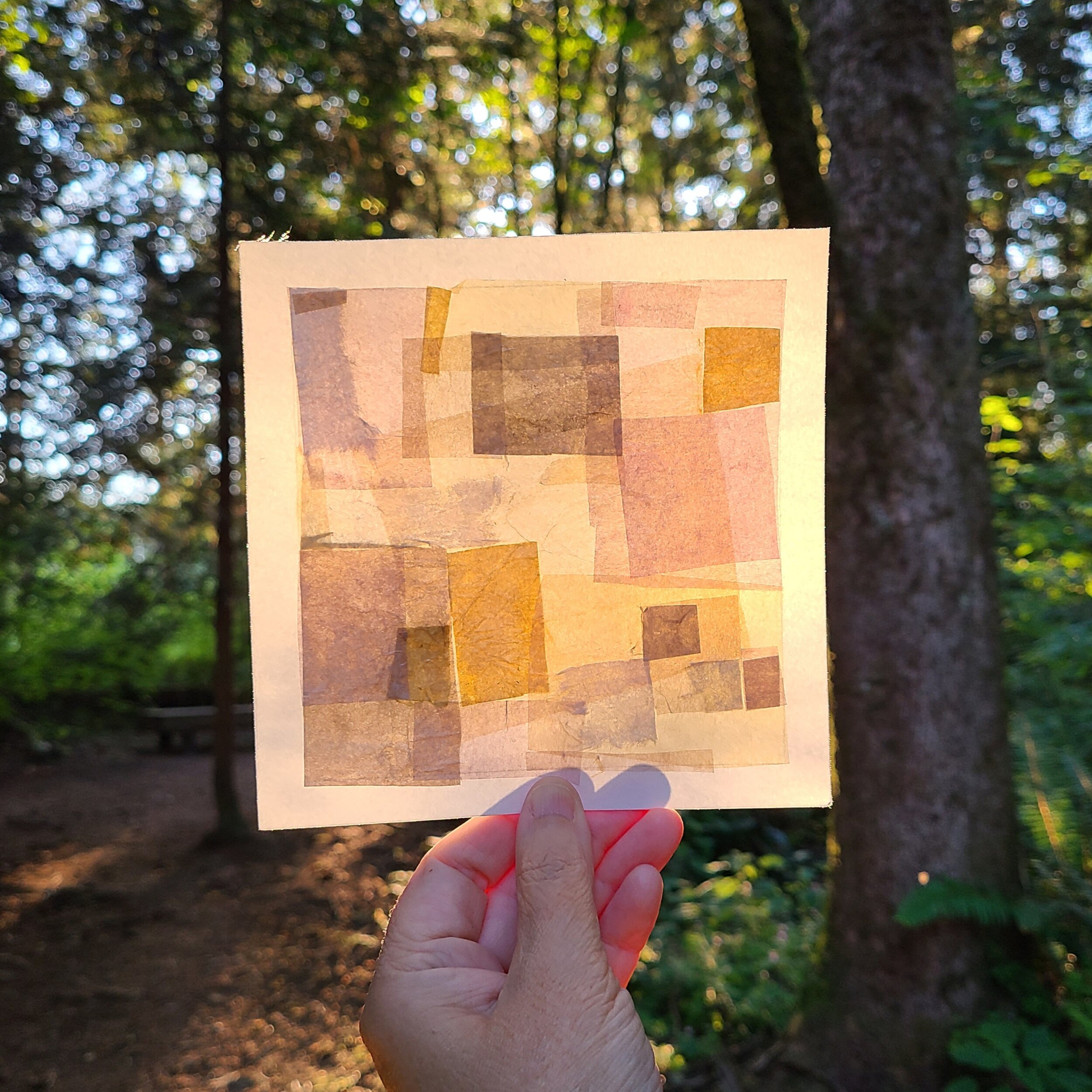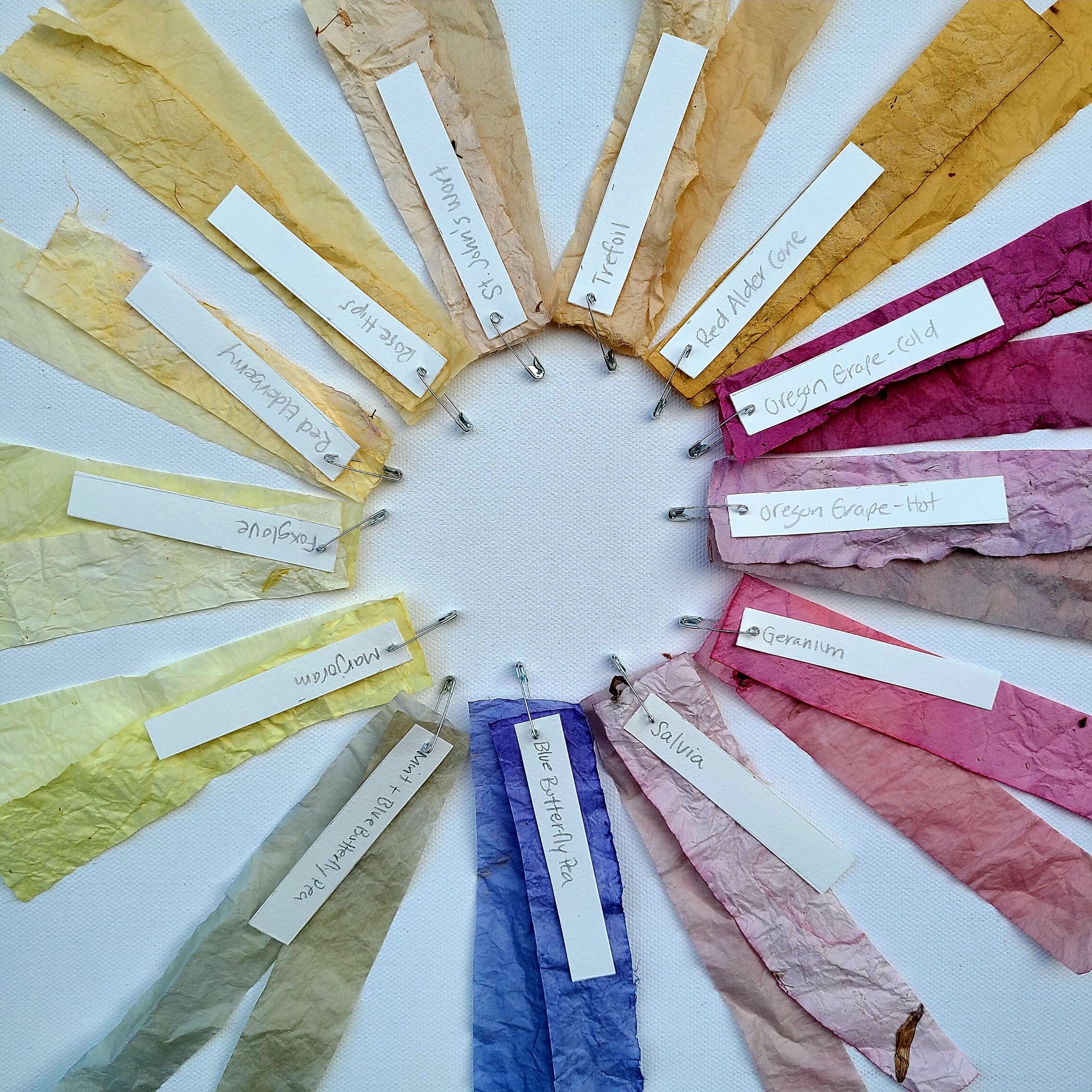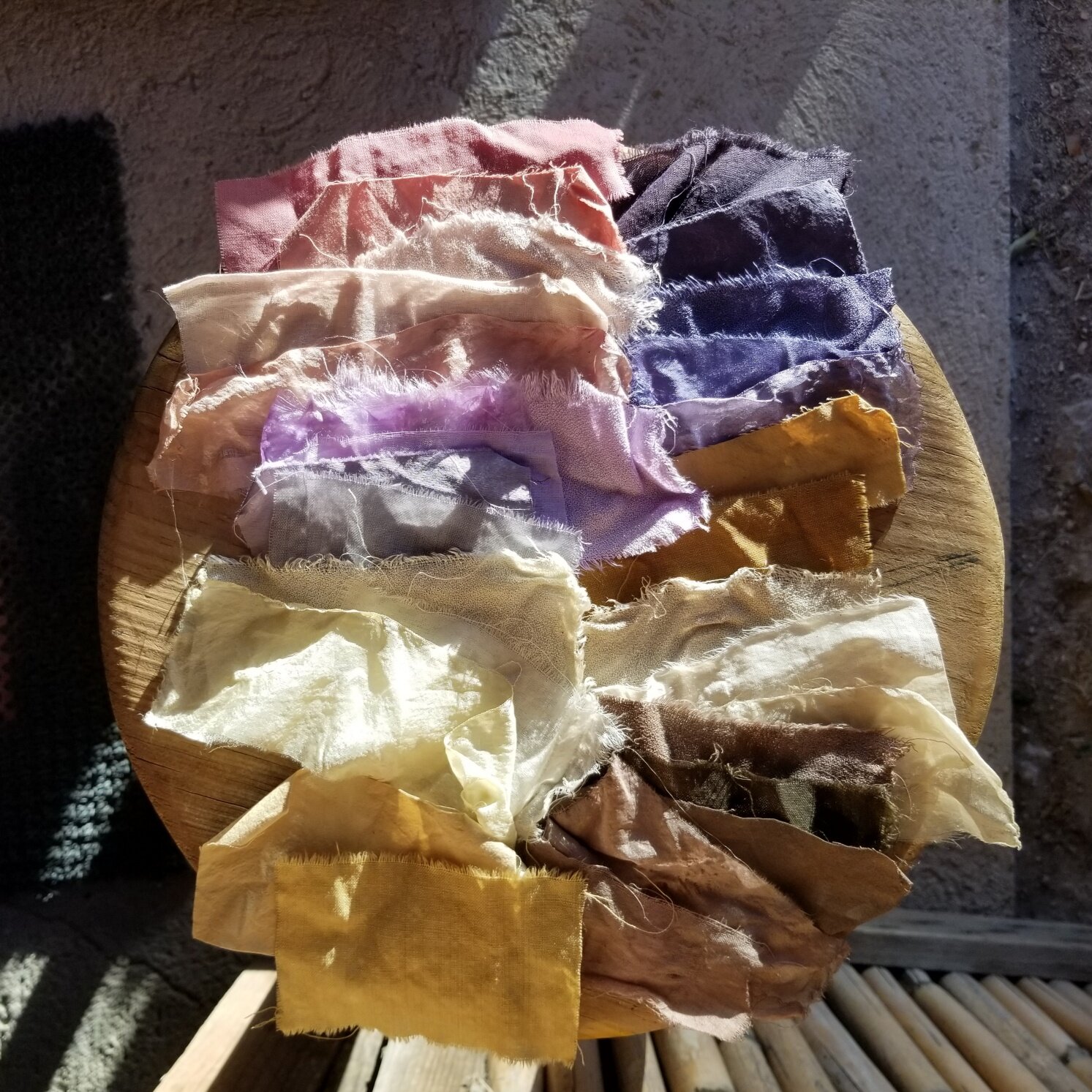Welcome to my new YouTube channel, Margaret Byrd:Color Quest as I move my Trail Tales blog to a vlog! Every Friday, I release new video content focused on the amazing world of natural color. Join me as I explore ways to forage and invite organic color into my creative practice.
The Art of Craft
Small craft advisory
As an artist, I aspire to be crafty.
Forget the misguided, and tragically oppressive Western narrative of ‘high art’ as somehow ‘enlightened’ and more valuable than the exquisite beauty found across all creative expression labeled as ‘craft’.
If you can translate an idea from mind to hand, the material is immaterial – you are an artist - plain and simple.
My creative curiosity has led me down a crafty path or two, and I’m now enamored with one diversion so often associated with handiwork: natural dyeing.
Some of my kitchen favorites for natural dye: avocado, turmeric, red cabbage and black bean.
While I could fight against the notion that this diminishes the value of my art, why would I entertain such a silly thought?
Nope. I choose to celebrate, my artist friends, so let’s get crafting with natural color!
Color classics
Focusing on colors from nature in #The100DayProject has filled my fridge with an incredible rainbow of botanical dyes.
Dyes brewed from foraged plants and food scraps during #The100DayProject.
Every time I find a new plant to brew, I add to my collection. When I see a color missing, I go searching for a plant. It is a never-ending exploratory cycle.
10 dye plants foraged from Tambark Park and my garden waste to study local flora colors.
As I shared my project, and the art I created with these dyes, I could hear the buzz all around me as people became curious themselves. Certainly interested, and maybe even inspired, to learn about natural dyes.
I get this. I have a history of being intrigued myself. It’s how this passion for organic color grew and how I learned what I know so far. Ironically, it seems the more you know, the more you want to know.
Having had many of the same questions when I started my love affair with nature’s palette in 2017, I have been searching high and low for answers ever since.
When I learned from a Dutch artist that seaweed was a sustainable source of dye, I headed to Iceland to investigate.
And, because sharing is caring, I’m very excited to tell you a secret I’ve been keeping all to myself:
Starting in August 2020, I will be releasing short tutorial videos and mini-courses all about the incredible world of natural color. My intention is to build a place where you can easily find the basics to get you inspired to add color to your life naturally.
Soon to be released YouTube channel, Cookin’ Color, with short video tutorials on organic dyes, August 2020.
The topic is HUGE. There are so many options and different approaches to extracting color, plus a multitude of ways to use it.
For me, organic color has been an integral part of my installation practice, and more recently my mixed media work. But a beautiful aspect of natural color is that it is available to everyone, no matter where you consider yourself on the art/craft spectrum.
Bioplastics cooked and cured with natural dyes in my kitchen studio in June 2020.
And, the botanical dye in my fridge right now is a perfect example of the countless ways we can weave natural color into almost everything.
Nature’s bounty
Finding a way to create color in an ephemeral installation without hurting an environment is how I got hooked on natural dyes. But as my #100DaysOfNaturesColors meandered its way through botanical dyes and earth pigments, I could clearly see just how many different ways I have been exploring color from nature. Maybe one or more of these will strike a creative chord with you too!
TEXTILE
Probably the most obvious and popular use of natural dyes is to create sumptuous hues for fabric. With a growing interest of sustainability in fashion, botanical colors are popping up from head to toe. If you’ve got natural fibers in your closet (cotton, hemp, silk, wool), you can dye organically – the options are endless.
Textiles of wool, silk, cotton and bamboo hand-dyed in Oaxaca exclusively with organic matter.
My first on-line workshop will be on how to create an ombre-dyed scarf from foods in your kitchen, and this fall, I will be teaching a similar technique using earth pigments. Incorporating these rich colors into a wardrobe is a delicious way to get your art out of the house.
However, if knitting or weaving is more your speed, soaking yarn, string or ribbon in a batch of botanicals can create subtle sweetness. Just look at the wonder of this wool I dyed in Mexico.
Wood hand-dyed in organic matter including indigo, muicle, pericon and cochineal in Oaxaca, Mexico.
While I preferred to use this fiber for installation, imagine a hat, scarf, mittens or sweater with that special colorful touch?
But who says you have to wear hand-dyed textiles? My mom was an avid quilter which I’m certain has influenced my mixed media textile pieces and love of squares.
Naturally dyed textile piece, Blossom, created while on residency in Oaxaca, Mexico, March 2020.
How special it would have been to forage with my mom and organically dye fabric swatches for her to sew into her quilt creations. Keep that in mind for the quilters in your life.
PAPER
Textile’s extended fiber family is paper. The delicate translucency of paper has intrigued me for quite some time, both for sculptural and 2D applications. In Oaxaca, I first tested how wet strength fibers like mulberry and tissue would hold the colors I had brewed, and it worked like a charm.
First time hand-dyeing paper with plant matter in Oaxaca, Mexico, March 2020.
So, one chunk of 10 days during #The100DayProject, I focused on creating collage with these dyed papers. The variations of color, especially when layering, felt closely tied to the depth I love to create with overlays of silk in my textile pieces.
Hand-dyed paper collage backlit in Tambark Park, made exclusively from organic dyes foraged in Oaxaca, Mexico.
Feeling inspired, I foraged local ‘weeds’ in my beloved Tambark Park the last 10 days of the project and made a new rainbow stock of colorful paper from the PNW.
Paper samples of natural dyes brewed from foraged plants in my neighborhood. Only blue butterfly pea was from my kitchen!
What’s wonderful about paper is its versatility across several art disciplines, and a true staple in many craft projects. Why not make hand-dyed paper with plants foraged from your neighborhood the next time the scissors and glue need some exercise?
INK
Dyeing paper is one way to spread some of nature’s colors around, but making ink turns just about any organic matter into a medium for drawing and watercolor fun.
I simply poured the dyes I brewed from foraged plants in Iceland and Mexico on paper, but learning how to make ink specifically was yet another way to expand my natural color wheel during the last 100 days.
Testing inks made from avocado skin and red cabbage during #The100DayProject.
I even made blue ink with my cherished blue butterfly pea blossoms for the first time, one of the most elusive colors of nature.
Watch out - lake pigments might be just around the next corner!
KITCHEN KRAFT
While all of the above may result in time at a craft table, a stovetop is still a critical element in a studio of natural dyes. Therefore, it’s no surprise that crafts of the kitchen can also add a splash of organic color.
Much of my installation work was born in the kitchen - infused ice, mung bean and playdough have been some of my edible shining stars.
Mung bean string installation naturally dyed with kitchen scraps in Sayulita, Mexico, December 2018.
Brewing organic dyes as natural food coloring for baking, cooking and blended drinks is certainly a fun way to add color in the kitchen. At the very least, you can start with next year’s Easter eggs having that natural color vibe.
This year’s Easter Eggs were dyed au naturel in turmeric, red beet, red cabbage, avocado and blue butterfly pea.
Plus, the kitchen is the perfect place to start playing with natural dyes in general. So many fruits/veggies, spices and even food scraps can make wonderful colors with very simple recipes.
In case you missed it this spring, download a copy of my Cookin’ Color brew booklet with a few of my favorite kitchen dye recipes, or better yet, sign up here for my 5 Days of Dye short video tutorial series releasing soon in a kitchen near you!
HEADING
Go ahead – call me crafty. I don’t mind at all.
To be honest, I question why any negative association became attached to a word that honors the vision and skill it takes to create beauty with your hands. To be an accomplished craftsperson is a lofty goal for any artist, and certainly one I aim for in my daily practice.
So, let’s keep spreading the art of craft in the world today!
Beyond Measure
For good measure
One of my new favorite sayings is ‘you can’t manage what you don’t measure’. It is a gem of Peter Drucker’s thought that I’ve applied to just about everything in my life recently:
The food I’m eating, particularly the sugar (cause of most evil in the world!)
The growing number on my email list (many, many thanks to all of you!)
The distance and length of time of my daily walk (finally a habit!)
I’m sure I’ve annoyed my closest friends by spewing this wisdom a few too many times.
Funny enough, measurement is strangely absent from much of my creative practice. My tendency is to eye it, guesstimate, and just plain wing it most of the time. The result is an inexplicable delight of the unknown.
Will it work? I never know, but I trust the surprise I may stumble upon is often better than any measured steps I could have meticulously planned.
Bob Ross calls these happy accidents, and I’m perfectly content crashing into some of my most beloved creations.
Bumping into the one and only Bob Ross at the Funko headquarters in Everett, WA 2019.
Drastic measures
Having a happy accident in art school may have started this trend of semi-controlled spontaneity. It is an example I speak of often, and I believe I may have even mentioned it in a Trail Tales blog of yore. Forgive the repetition, but I suppose that is how what we learn can truly sink in.
At the University of Montana, the Ceramics Department is world-renowned, many thanks to the unique work of Rudy Autio that pushed the conventional boundaries of clay. As a BFA student, everyone is required to take Ceramics 101 at the very minimum.
One of the beautiful slices of U of M art school is that it was the most welcoming, inclusive, non-competitive and encouraging environments I have ever experienced. I count myself extraordinarily lucky as I understand this experience is not always shared among other BFA programs.
Walking in as a complete newbie, I was wowed by the amazing work being produced by the graduate students, and incredibly inspired to bumble my way through an art form that has its roots in measurement. My professor, Beth Lo, was kind and generous in sharing her knowledge of this ancient art form, and I honestly tried to follow all the steps on each project we were assigned.
Honest.
Our final project was a chance to design anything we wanted to be saggar-fired in a vessel we built ourselves. As my 3D intrigue was beginning to bubble, as well as my installation curiosity and unexplained love of all things square, I knew exactly what mixed media magic I wanted to create, and I quickly sketched the design and built a board to describe my vision.
One of my BFA thesis mixed media pieces used in an installation. This was the vision I had for my ceramics project.
When Professor Lo pulled the vessel from the fire, she warned me that I would be extremely disappointed in the result because it was nothing like what I had planned.
The center piece of the biggest mistake in my art career, 1995.
True, the 5 cube forms were not the smooth porcelain surface I was after, nor the rusty colors of the earth. They were a bubbly mess of grays and blues with ashen edges. My idea of embedding polaroid transfers into the center square was quickly washed away by residual globules of mis-measured glazes that had an unexpected combustion soirée in the kiln.
I was blown away, smiling from ear to ear, because I could never have planned such surprising beauty. At that moment, my professor told me I would be well-suited in the wild world of art.
Measure up
For the past two years, I have become passionate about extracting color from nature. Much of this was driven by a desire to use only organic matter in my installation practice, particularly when leaving a piece of art to dissipate into the earth.
Starting in my kitchen, I began brewing colors from spices and vegetables I found in my cabinets and fridge. From there, I became curious about foraging for botanicals and experimented by creating dyes from seaweed and lichen. My longstanding love of stone lead me to the world of minerals and earth pigments. Yes, I am officially addicted to the quest for a natural palette.
The colors of the rainbow courtesy of Moonstone Beach in Cambria, CA.
And, the exploration continues. Today, I am writing from my artist residency studio in Oaxaca, Mexico, a global center for textiles and botanical dyeing. My intention is to learn by doing with hands-on instruction from a dye master of the region, as opposed to my stand-by instructor known as the internet.
How will things measure up?
In short measure
As I’ve quietly entered the wide world of natural dyeing, I’ve become acutely aware that ratios, weights and recipes are quite important in assuring a desired color result. I have the utmost respect for the long history of passing precise knowledge from master to pupil. Beyond that, I am humbly grateful to have the unique opportunity to simply learn about botanical dyeing.
My master, Manuel, teaching me the Zapotec dye tradition from the Oaxacan region in Mexico, Feb 2020.
Manuel, the dye master in my residency, has shared many local practices along with some practical advice about what to avoid:
Don’t let your dye come to a boil to avoid losing the colorant to vapor
Don’t brew your textile with your botanical material to avoid splotching
Don’t let the textile touch the bottom of the dye pot to avoid color variation
Don’t stray far from the ratio of plant-to-water-to-textile to avoid weak color saturation
Don’t dry your fabric in the direct sunlight to avoid quick color fading
All of this makes perfect sense in the world of order and consistency, but as Manuel noted, none of it is a guarantee of color perfection to match your mind’s eye. It’s Mother Nature’s job to figure that out for you.
With this wisdom, I believe I’m perfectly suited for organic dyeing. The joy I experience is in the unique variation of color that nature chooses to surprise me with every single time.
First color swatches in my residency studio with textiles brought from the US and NL. Excited for the wool yarn soon to dye at the farm with Manuel!
In fact, I hope to never dye the same color twice, and splotches – bring ‘em on!
In equal measures
On my mantle, I lovingly display the biggest mistake of my BFA program, and my most cherished piece of art. These explosive cubes of clay are a constant reminder that although measurement is important, celebrating the unexpected is the spark of life.
Wonder what color surprises Oaxaca holds for me the next few weeks? Stick around for the big reveal in next month’s Trail Tales!
